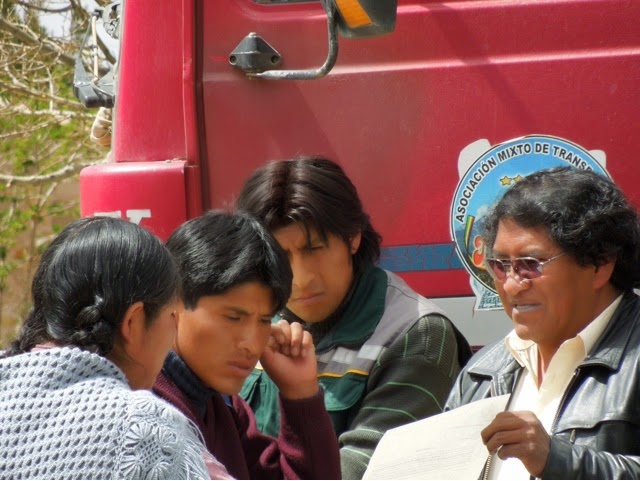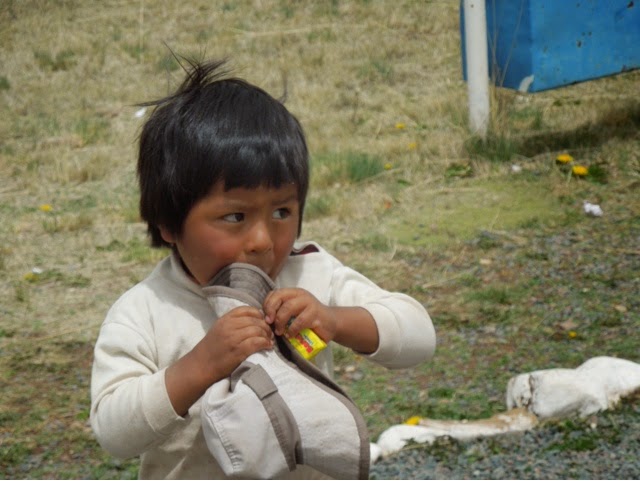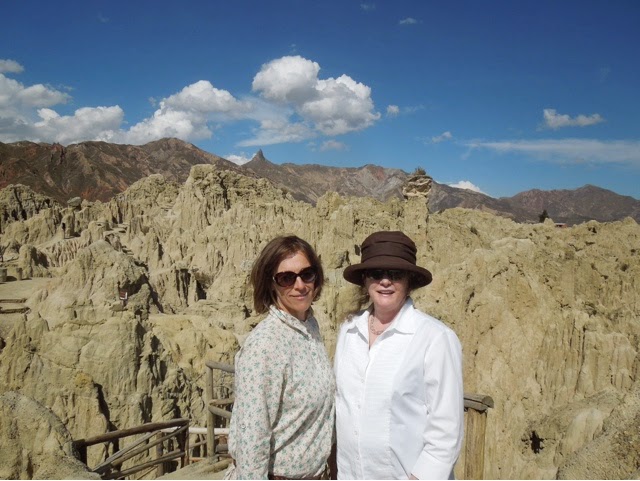An immense , sapphire - blue lake sitting astride the border with Peru at the northern end of the Altiplano, it is one of the classic images of Boliva. the lake is at an altitude of 12,000 feet, measuring 1200 miles by 48 miles. The remnant of an ancient inland sea formed as the Andes were thrust up from the ocean floor. The surrounding area is the heartland of the Aymara. The lake is rich in fish, and the water it conains stores the heat of the sun and then releases it overnight, raising average temperatures around its shores. This makes this region one of the most productive of the high Andes. The water level in the lake fluctuates sharply with slight variations in rainfall; since 2000 levels have fallen to historic lows.
This little island is the home to Bolivian's most important Catholic shrine, the Virgen of Copacabana. Several times annually the town is overwhelmed by religious devotees who come to pay homage to the Virgin in colorful religious fiestas. The Virgen de Copacabana emerged as the most revered religious image in the Altiplano. A slight image with an Andean face, the Virgin wears lavish robes embroidered with gold and silver thread, and is crowned with a golden halo; at her feet is a wide silver crescent moon - a traditional Andean symbol of female divinity. Encased in glass, the statue is only taken out during fiestas (locals believe that floods would ensue if removed at any other time).
Copacabana's imposing Cathedral looks over Plaza 2 de Febrero. Known as the "Moorish Cathedral", it shows clear mudejar influences, with whitewashed stone, currently being painted white, and domes decorated with deep-blue azulejo tiles. Built between 1589 and 1669 by the Augustinian order and funded by looted gold and silver offerings from local Christians, to house the Virgen of Copacabana.
This is the most important religious sites in the Andean world., revered as a place where the sun and the moon were created and the Inca dynasty was born. After the Spanish conquest the island was looted, and the cut stones from its temples plundered to build churches on the mainland.
Surrounded by the azure Lago Titicaca, with the imperious peaks of the Cordillera Real rising above the shore on the mainland to the east, it's a place of great natural beauty and tranquillity.
ISLA DE LA LUNA
About 4 miles west of Isla del Sol, the smaller Island of the Moon was another important religious site. Made up of a single ridge. Known as the Coati "Queen Island" , it was assocaited with the moon, considered the female counterpart of the sun, and a powerful deity in her own right. It was where the head of the Inca Tribe would choose his bride. There were 100 virgins living on this island. The Inca ruler would choose one bride each year.
Evo Morales was elected president in 2005. The first indigenous - Aymara. He is the head of the coca grower's union and leader of the Movement towards Socialism. He was a radical indigenous activist who protested the pressure from the US , to eradicate the coca production. Under Morales's reign, the natural gas industry was nationalized, with troops occupying the foreign-owned wells, and a massive program of agrarian reform was launched to redistribute land. Determined to end the influence of what he saw as US imperialism, Morales instead cultivated links with Castro and Hugo Chavez in Venezuelan. The powerful business elite in Santa Cruz bitterly opposed his nationalization program, threatening to secede and using his own tactics of street protests and blockades.
He lowered his own salary as President to $2,000/month, and also lowered all the public workers salaries. Old problems of poverty, underdevelopment and ungovernability are still to be resolved.
In recent years coca- the crop's link to the international drug trade has remained a contentious issue. Morales scrapped legislation in 2010 to cut cocaine production after protest from coca growers. In 2011 Bolivia renounced a UN anti-drug convention because it classified coca as an illegal drug, a decision criticised by the US and several other countries. Subsequently, there is not a US embassador to Bolivia - he left in 2008.
There will be another Presidental election on October 12th of this year. Morales increased the term of the President, and will be running for another term.
Saying goodbye to the beautiful people of BOLIVIA



 Funeral pyre.
Funeral pyre. 












































